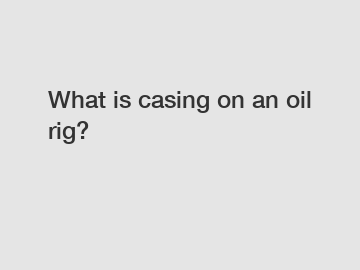What is casing on an oil rig?
What is Casing on an Oil Rig?
When it comes to drilling for oil, there are several crucial components in the process, one of which is casing. Casing plays a vital role in ensuring the stability and integrity of the well, protecting it from external forces and preventing any possible accidents or leaks. In this article, we will delve into what casing is, its purpose on an oil rig, and how it is installed.
What is Casing?

Casing refers to large-diameter pipes that are inserted into the wellbore during the drilling process. These pipes are typically made of steel and come in various sizes, depending on the specific drilling operation. They are designed to provide structural support to the well and protect it from any potential collapses or fluid leaks. Additionally, casing also helps to control the pressure of the well and prevents any unwanted fluids from entering into the surrounding formations.
The Purpose of Casing.
1. Providing Structural Support.
One of the primary purposes of casing is to provide a stable structure for the well. As the drilling process progresses, the wellbore is subjected to high pressures from the surrounding rocks and fluids. Without proper support, the wellbore may collapse under these pressures, leading to a range of safety hazards and operational issues. Casing serves as a strong and resilient barrier, ensuring the stability and integrity of the well as it reaches deeper into the earth.
2. Preventing Fluid Leaks.
Another crucial aspect of casing is its ability to prevent any fluid leaks from the wellbore. During the drilling process, the well encounters various formations with different fluid pressures. Casing acts as a seal, inhibiting any potential leaks or contamination of the surrounding environment. It is essential to maintain the integrity of the well to ensure the safety of workers and protect the environment.
Casing Installation Process.
1. Surface Casing.
The first piece of casing that is inserted into the well is called the surface casing. This casing is relatively large in diameter and is cemented to the upper portion of the well to provide a stable foundation. It prevents the upper section of the well from collapsing and protects the shallow formations from potential leaks during drilling.
2. Intermediate and Production Casing.
After the surface casing is in place, intermediate casing is then used to drill deeper into the earth. This casing provides additional support to the well and helps control pressure in different formations. Finally, the production casing is installed, allowing for the extraction of oil or gas from the reservoir. Each casing string is cemented in place to ensure stability and integrity.
Conclusion.
Casing plays a critical role in the drilling process on an oil rig. It provides structural support, prevents fluid leaks, and helps control pressure within the well. Without casing, the integrity of the well would be compromised, posing significant safety risks and possible environmental damage. If you have any further questions about casing or require assistance with an oil drilling operation, please do not hesitate to contact us.
Contact Us.
For any inquiries or assistance regarding casing or oil rig operations, please feel free to contact us at [insert contact information here]. We are always ready to provide our expertise and support for your drilling needs.
Are you interested in learning more about K55 casing, OCTG Pipe Suppliers, Oil Casing And Tubing? Contact us today to secure an expert consultation!


